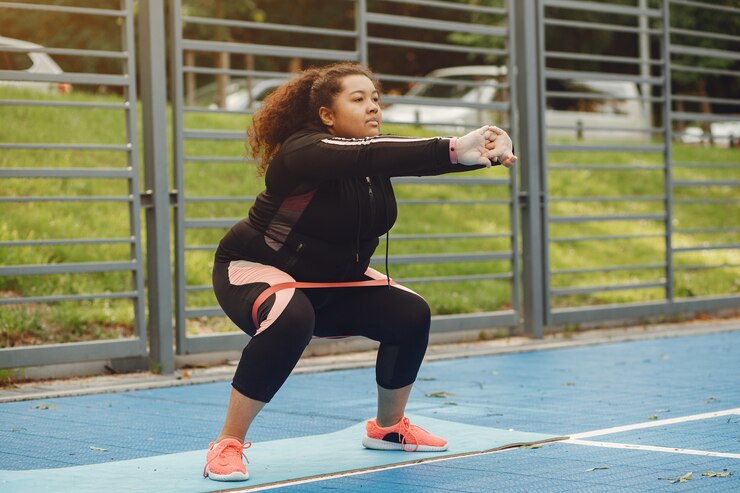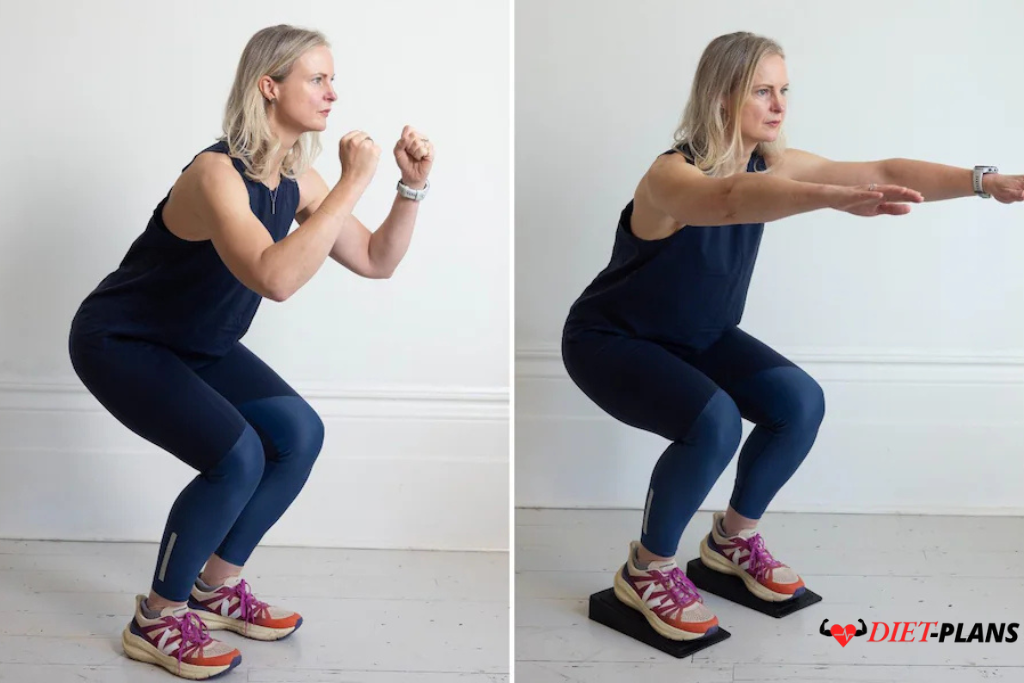Squats: The Miracle Workout When Done Right
I worked out with the strength and conditioning coach at my club when I first resumed rowing at the age of 48. He identified the issue as soon as he saw my pitiful efforts at a barbell back squat. Even without a weight on the bar on my back, I could hardly bend my legs halfway, and it wasn’t because of my weak quadriceps and glutes, hips, or unsteady knees, but rather because my ankles weren’t functional.
I was irritated after ten years of power-walking marathons. However, it’s a typical issue. Indeed, research indicates that many of us have mobility and balance problems as we age due to a reduction in ankle strength and range of motion, which may be made worse by our propensity to sit for extended periods.

Fortunately, I’ve discovered a way to overcome my lack of flexibility: elevated or heel-raised squats, which are performed while standing on wedges or, in fact, any elevated surface, such as a metal weight. These have been shown to improve quad strength, alleviate ankle inflexibility, and encourage improved posture. After a month of doing them, the effects have been life-changing.
The Advantages of Squats
First, then, what are the advantages of doing any kind of squat, whether it be raised or not? “Squats are one of the best exercises for developing power and strength in your main muscles below the waist—your glutes, quads, and your hamstrings,” explains sports scientist Liam Grimley. Additionally, squats will strengthen your hip flexors and tone your calves. Additionally, you must use your trunk and deeper core muscles to maintain your stability to form the traditional squat “S” shape, which has your chest front and your bum protruding.
Additionally, 2019 research found that squats improved bone mineral density in postmenopausal individuals with osteoporosis or osteopenia, demonstrating that squats help maintain healthy bones as we age. King Charles recently acknowledged that he does pull-ups and squats as part of his daily practice. He has long been a fan of the Canadian Royal Air Force’s 11-minute 5BX program, which combines bodyweight and aerobic exercises.
Are Regular Squats or Elevated Squats Superior?
“I would recommend using a wedge if you’re stiff and having trouble getting the basic squat right,” says Grimley, a sports rehabilitation specialist. People with desk or driving-based jobs who sit with their ankles at a 90-degree angle to their shins often develop stiff ankles. You lose the natural dorsiflexion—the lifting of the foot toward the shins—that occurs when you are actively walking, jogging, crouching, or ascending stairs while you are in that posture.
Although tight ankles might result in poor technique and increase the risk of back injury for someone like me, higher squats aren’t always preferable.
According to 2017 research, having tight ankles causes us to stoop too forward, which might make lower back issues worse. Conversely, a wedge may help us squat more comfortably and lower our chance of injury. They are perfect for me since I have a history of lower back problems from rowing with wooden boats and blades in the 1990s.
In 2022 research that was published in Human Movement, 15 weightlifters who experimented with varying heel elevations—both barefoot and with 25mm and 50mm wooden wedges—performed back squats. The authors of the research discovered that the more upright the trunk posture throughout the workout, the higher the wedge, which lessened lower back strain.
They also mentioned that the 50mm wedge worked well for extending the ankle range of motion. Additionally, the wedge increases knee flexion, which may strengthen the surrounding muscles and knee joint.
My Program of Raised Squats
Strength training is my weakness, even though I work out many times a week, exercising on the river and the rowing machine. I find lifting weights to be tiresome and time-consuming, and I don’t feel like I’m exerting myself enough.
In addition to my routine, I decided to follow the King’s example and do little but often each day. I began by doing three sets of ten raised squats each day, interspersed with abdominal exercises, stretching, and dorsal raises, which strengthen your back and bottom. To be honest, I was beginning from a respectable level of fitness despite my low ankle mobility. I quickly discovered that I wasn’t pushing myself enough while doing the fundamental bodyweight squat.
Grimley describes my feelings by saying, “Start with a bodyweight-only squat if you’re a total newbie or someone in rehab. It’s critical to master the mechanics, and the wedges will ensure that your movement is full and sound. You are most likely plateauing or possibly losing the strength you have gained after you can do more than 20 body-weight squats.”
Applying the progressive overload approach and increasing the resistance will make the number of repetitions difficult. You must add a load, which might be a weight you are holding, a bar on your back, or even a resistance band. After ten repetitions, it should be exhausting. Because your body is so adept at adjusting, the secret is to constantly challenge it. After speaking with him halfway through my training month, I advanced to doing raised goblet squats from the comfort of my own house with a 5 kg weight.
Taking Deeper and Heavier Lifts
I quickly discovered that employing the heel wedge allows me to dive deeper and lift more weight, which is another advantage of raised squats. The ability to “perform good movement under a greater load without loss of form or form failure, because you can go lower while maintaining that more upright spine position,” is one of the benefits of the heel wedge, according to Grimley. You will benefit more from a more full squat.
That is to say, raised squats serve a similar purpose as lifting shoes. Professional weightlifters will perform better on competition day if they have a modest heel lift since it enables them to lift greater weights, he continues. Additionally, being overweight puts additional strain and stimulation on your body.
When you do a raised squat, your posture changes, which also affects which muscles are used. Your glutes are being worked the most during a typical squat. However, 2022 research found that raising the heels increases the range of motion in the knees, particularly in males. This increases the activation of the outer quadriceps, the gastrocnemius calf muscle, and the biceps femoris, a posterior muscle that aids in the movement of the hip and knee joints. Elevated squats also made the ankle work harder, according to the same research.
What I Learned After Doing Raised Squats for a Month
My quadriceps are stronger, my creaky knees feel more solid, and I can lift greater weights—even while doing a standard barbell squat without elevation—after a month-long regimen of daily repetitions. In addition, my lower back hasn’t changed in any way.
Does all of that, nonetheless, imply that I should do raised squats constantly? Grimley disagrees. Putting on my rehab hat, he states, “In general, we need a wedge because we have a deficiency.” Therefore, it would be good to move on from the wedge or for it to serve just as a tool to assist you lift more weights rather than as something that improves your squat technique. Regular practice combined with wedge squats and gradually experimenting with lowering the height of the wedge is the best approach.
Which option you choose ultimately relies on your training objectives, desired lift volume, and desired lower body area for increased effort.
Purchase some appropriate wedges from Amazon or a store that sells exercise equipment. I made use of the smaller wedge, which had an elevation of 5.5 cm. Although they are less steady, you may also stand on the solid circular metal weights that you see in gyms. Place your feet on the wedges, which should be shoulder-width apart or a little wider; if you don’t have a weight, you may perform this barefoot.
You may lift your arms while you do the squat by crossing them in front of you, behind your head, or by your sides. Bend your knees until your legs are parallel to the floor, or lower while keeping your chest out and your core and glutes active. With less strain on the shins, you should be able to go lower than in a typical bodyweight squat. Get back to standing, do it 10 times, then take a break and do it three more times. Once you are comfortable with the action and can easily complete the amount of repetitions, you may increase the difficulty of the exercise by holding a dumbbell in front of you.

